Database of luminescent minerals
hyalite
Chemical formula: See OPALE
Family: Oxides and hydroxides
Status: NON APPR
Crystal system : Amorphous
Display mineral: OUI
Luminescence:
Longwave UV (365nm) colors: |
Green , | ||
Intensity LW:Weak | Frequency LW:Often | ||
Midwave UV (320nm) colors: |
Green , | ||
Shortwave UV (254nm) colors: |
Green , | ||
Intensity SW:Strong | Frequency SW:Very often | ||
Daylight picture

Hyalite, Valeč, Czech Republic;
Col. G.Barmarin; Photo: G. Barmarin
Shortwave (254nm) picture

Hyalite, Valeč, Czech Republic; UVSW
Col. G.Barmarin; Photo: G. Barmarin
Pictures Galery:

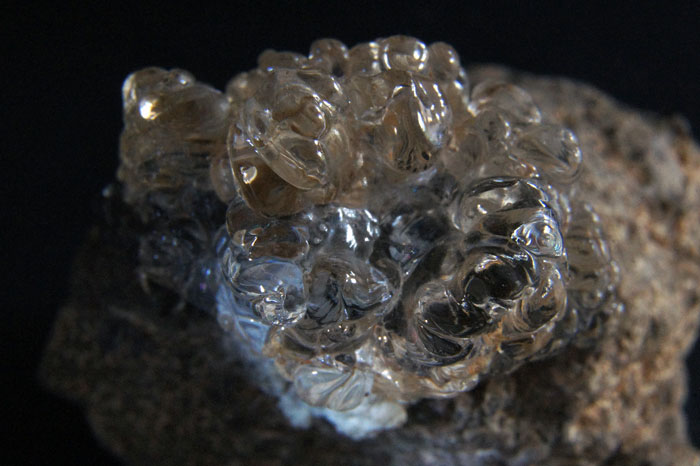
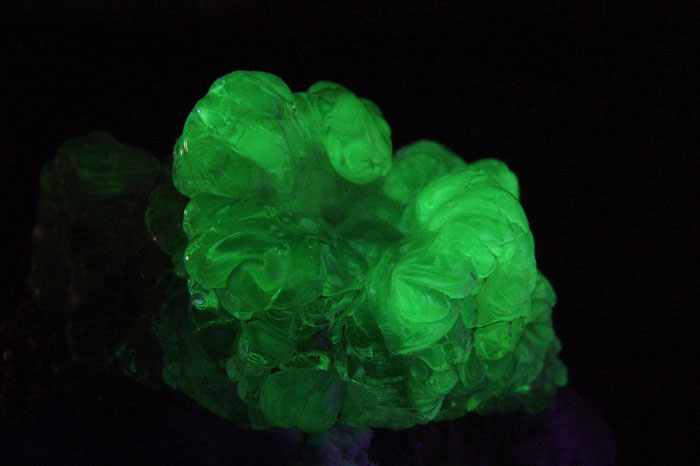
Do you have a photo of this mineral you would like to see in the gallery? Contact us!
Phosphorescence (in the common sense of the term) observable with the naked eye:
No phosphorescence visible to the naked eye under any type of UV
Comments:
A colourless variety of Opal. Hyalite is opal-AN, an amorphous silica-glass containing about 3-8% water.
Hyalite is quite often present as a coating almost invisible to the naked eye on quartz, feldspar, topaz, black tourmaline, aquamarine etc. falsely suggesting that these minerals fluoresce.
Activator(s) and spectrum:
Activator(s): (UO2)2+ (ion Uranyle) en impureté,
Peaks in the spectrum (nm):
UO22+ : 503, 524, 547, 570, 600nm
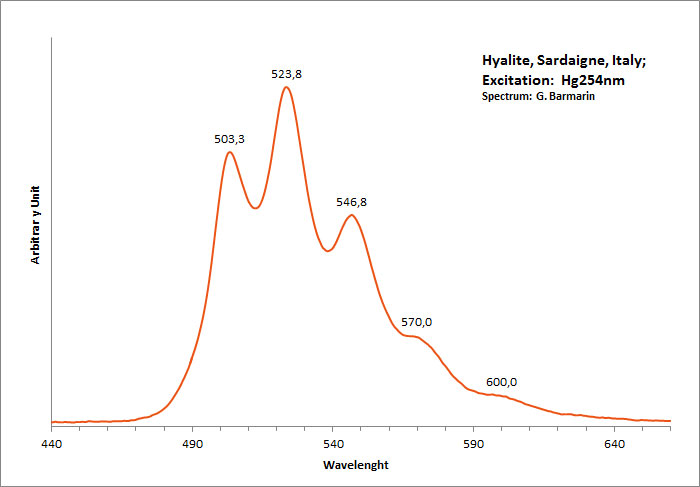
Col. G. Barmarin; Spectre: G. Barmarin
Spectrum of hyalite in CSV
You can download the CSV file by clicking here: fichier csv
Spectrum Galery:
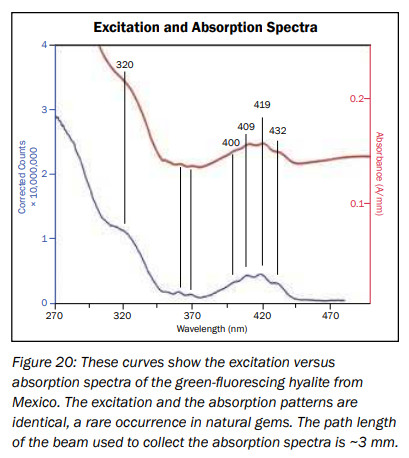

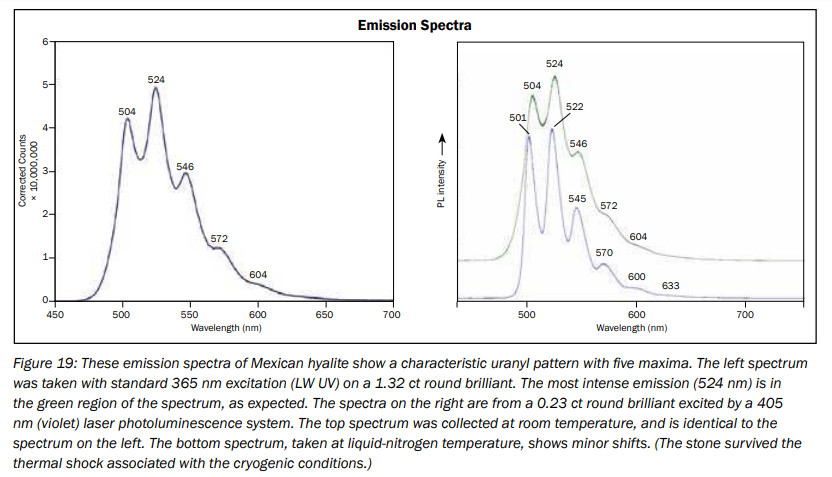 ...
...Comments on spectrum and activators:
Typical spectrum of Uranyl impurities.
Best localities for fluorescence (*):
- Valec (Waltsch), Doupov, Karlovy Vary Region, Bohemia, Czech Republic ;
- Tarcal, Eperjes-Tokaj Mts., Borsod-Abaúj-Zemplén, Hungary (coming on the market in Munchen in 2014, fluo strong green SW, moderate green LW);
- Kopasz Hill, Tállya, Zemplén Mountians, Borsod-Abaúj-Zemplén County, Hungary
- Monok, Zemplén Mts, Hungary ;
- Bárdos Hill, Gyöngyössolymos, Heves County, Mátra, Hungary ;
- Chalk Mountain Mine, Spruce Pine, Spruce Pine District, Mitchell Co., North Carolina, USA ;
- Erongo Mountains, Namibia ;
- Lesbos Island, Lésvos Prefecture, Aegean Islands Department, Greece (very similar to samples of Czech Republic);
- Squaretop Mountain, Kaimkillenbun, Wambo Shire, Western Downs Region, Queensland, Australia (similar to samples of Czech Republic but moderate lime-green fluo SW);
- Zacatecas, Mexico (coming on the market in 2014 in Tucson, very strong green fluo even in daylight!);
(*)The data are not exhaustive and are limited to a few remarkable localities for fluorescence
Bibliographic reference for luminescence:
- The Henkel Glossary of Fluorescent Minerals, Dr. Gerhard Henkel, Published by the FMS, 1989 ,
- Fluorescence: Gems and Minerals Under Ultraviolet Light, Manuel Robbins, 1994, Geoscience Press, ISBN 0-945005-13-X ,
- Luminescenza nel regno minerale, Guido Mazzoleni, fotografia Roberto Appiani, Libri Sandit, 2010, ISBN 978-88-95990-63-7 ,
- Handbook of Fluorescent Gems and Minerals, a practical guide for the gem and mineral collector, Jack de Ment, 1949 ,
Reference for luminescence on the Internet:
- Valec (Czech Republic) foundplace description (Mindat)
- https://www.academia.edu/31789056/Fritsch_al2015_Mexican_Luminescing_Hyalite_Jo_G2015_34_6
Images:
- Zacatecas, Mexico: https://www.mindat.org/photo-957214.html
Mineralogical reference on the Internet:
 http://www.mindat.org/show.php?name=Hyalite
http://www.mindat.org/show.php?name=Hyalite
 http://webmineral.com/data/Hyalite.shtml
http://webmineral.com/data/Hyalite.shtml
Internet Search:
 Image search on 'Google Images'
Image search on 'Google Images'
 Search for documents in all languages on Google
Search for documents in all languages on Google
A request providing no result means only that no such reference exists in the database, but it does not mean that what you are looking for does not exist, just not to our knowledge. If you think you have found an error or omission, please let us know via the contact page being sure to cite the source of information.

